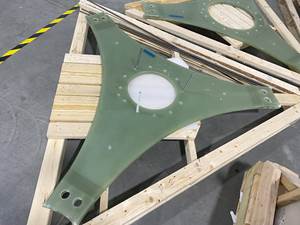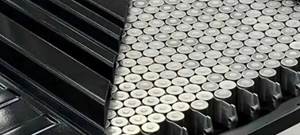CTL webinar presents HAWK project findings for airborne wind energy systems
Event featured insights from project partners regarding novel materials testing, addressing technical challenges and the path to certification to better understand AWE systems and their potential.
Michael Walls (CTL) and Edward Fagan (Zero Nexus) attending the AWEC24 conference in Madrid. Source | CTL
(CTL Tástáil Teo, Galway, Ireland) recently held a successful webinar where project partners discussed their research in airborne wind energy (AWE) systems. This project, “Hibernian Airborne Wind energy Kites” or HAWK for short, was funded by the Sustainable Energy Authority of Ireland (SEAI).
The event, hosted by Engineers Ireland, featured insights from the project’s partners: CTL, Airborne Wind Energy, Zero Nexus and the University of Galway. The webinar provided an in-depth overview of the project’s objectives, technology, material testing and certification challenges, as well as the potential for AWE systems to transform the wind energy landscape.
Read “Composites Testing Laboratory launches wind energy project HAWK”
AWE uses kites or drones that are tethered to the ground to generate electricity. There is a diverse set of challenges facing the adoption of AWE technology, including materials, product safety/regulation, technology feasibility and developing effective supply chains.
This project addressed those challenges, with the main objectives as follows:
- To test materials and create an open-source database
- To conduct techno-economic cost modeling of the airframe
- To map the supply chain requirements for airframe manufacturing
- To assess wing durability and maintenance schedules
- To produce a certification roadmap.
This activity will strengthen Ireland’s reputation in the AWE space and is expected to encourage increased international collaboration.
During the presentation, speakers discussed topics around Integrating AWE into IEC 61400, creating a novel composite material database for fixed-wing airborne wind energy kite, durability assessment of the wing structure in an AWE system and their paths to certification.
CTL reports the following key insights from the webinar:
- AWE taps into high-altitude wind resources, enhancing energy generation potential compared to traditional turbines. This enables greater efficiency and reduced land use.
- The HAWK project has successfully developed a composite material database, promoting innovation in material science for more efficient and sustainable AWE systems.
- Sustainability is at the forefront of material selection, with a focus on recyclability and reduced environmental impact in the lifecycle of AWE systems.
- FEA models were presented which analyzed the structural durability of the main wing of a fixed-wing AWE kite.
- Certification processes for AWE systems are complex, requiring a balance between aviation safety and wind energy standards, highlighting the need for tailored regulatory frameworks.
- Standardization efforts are crucial for the AWE sector, as existing wind turbine standards may not fully apply to airborne systems, necessitating new guidelines for safety and performance.
The HAWK project was a collaboration between academic institutions and industry leaders. As AWE continues to evolve, the project’s research will be instrumental in creating new pathways to a more sustainable and energy-efficient future. .
Related Content
RTM, dry braided fabric enable faster, cost-effective manufacture for hydrokinetic turbine components
Switching from prepreg to RTM led to significant time and cost savings for the manufacture of fiberglass struts and complex carbon fiber composite foils that power ORPC’s RivGen systems.
Read MorePolar Technology develops innovative solutions for hydrogen storage
Conformable “Hydrogen in a Box” prototype for compressed gas storage has been tested to 350 and 700 bar, liquid hydrogen storage is being evaluated.
Read MoreComposites end markets: Batteries and fuel cells (2024)
As the number of battery and fuel cell electric vehicles (EVs) grows, so do the opportunities for composites in battery enclosures and components for fuel cells.
Read MoreComposites end markets: Energy (2024)
Composites are used widely in oil/gas, wind and other renewable energy applications. Despite market challenges, growth potential and innovation for composites continue.
Read MoreRead Next
ORNL demonstrates lightning strike protection tech for composites
Researchers, led by Vipin Kumar, developed a low-cost, recyclable carbon fiber wind turbine blade tip that showed resilience to high-voltage lightning strikes, with more innovations in store.
Read MoreKite-based energy system aims for high-output, low-impact wind energy
Netherlands-based startup Kitepower’s Falcon airborne wind energy (AWE) system deploys a fiberglass-intensive kite to generate wind energy with a low ground footprint.
Read MoreNext-gen fan blades: Hybrid twin RTM, printed sensors, laser shock disassembly
MORPHO project demonstrates blade with 20% faster RTM cure cycle, uses AI-based monitoring for improved maintenance/life cycle management and proves laser shock disassembly for recycling.
Read More












